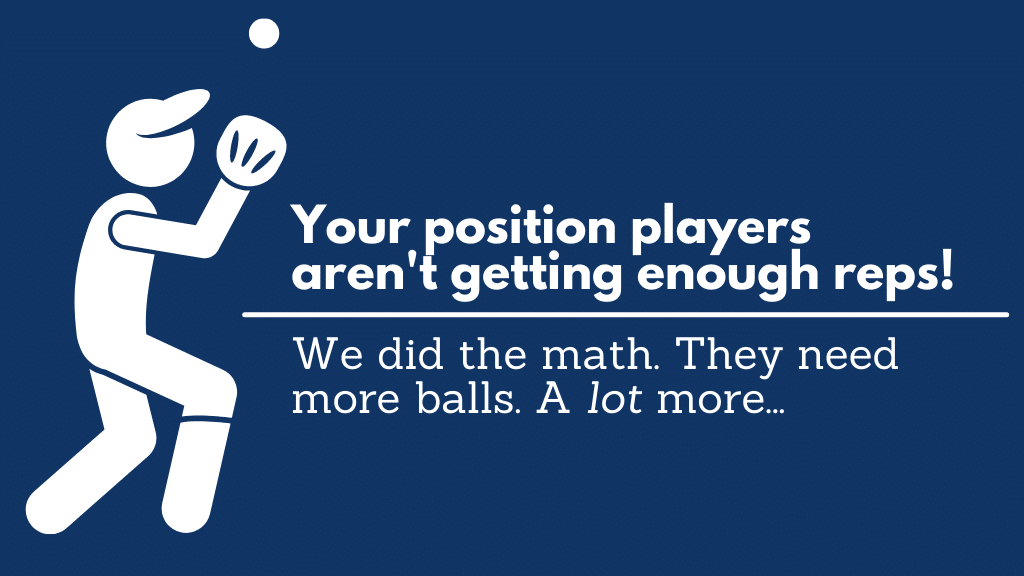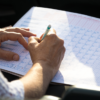In an earlier post I argued that hitters see too few simulated pitches compared to standard batting practice repetitions. When it comes to fielding, I think the opposite is true—that coaches are inclined to spend too much time on situational, simulated, and team defense and not enough on isolated skill development.
The number of variables at play when hitting live pitching is large, and most of those variables cannot be replicated when a coach or teammate throws from behind a screen. Further, many of those variables are external—they are based on the pitcher’s decisions and execution, not the hitter’s. That’s why simulation is so important—hitters need to not only improve their own skills, but also learn to how execute those skills in contextual situations that are beyond their control.
Conversely, the variables that affect whether or not a defender fields a ball cleanly change very little from play to play and are almost entirely dependent on the player’s own execution, such as approach to the ball, position relative to the ball, and posture. The variables which are out of the fielder’s control are generally random events (such as bad hops or strange spin), and need not be realistically trained for—those random events will inevitably be produced if the sample size of repetitions is sufficient.
For these reasons, I think repetition is more effective at reducing errors than it is at increasing offensive production. Just how many raw repetitions compared to how many situational repetitions is a different question.
For teams that practice two or three times per week, my baseline goal is to provide each infielder with at least 50 batted game-speed balls per day (100-150 per week). That per-week number should be higher for teams that practice 5 days per week, and lower for youth teams for which it would represent a greater physical burden (and impede other parts of practice).
Outfielders are not typically able to complete as many raw repetitions, primarily because their reps require significantly more running. In my opinion, all outfielders should receive a minimum of 10-20 batted balls per practice which aim to expand their range, as well as 10-20 that deal with personal weaknesses (such as height judgment or deep back drops). However, the specific number that works for a particular teams depends largely on athleticism.
At lowers level of play, coaches typically field a full defence and hit balls one at a time. Whether or not this is situational (with real or simulated runners), the effect is that there’s probably about a 30-60 second delay (at minimum) between each repetition. If we assume the best-case scenario is that each rep takes 30 seconds, then a coach can hit a maximum of 120 balls per hour assuming he or she takes no breaks and does not stop to speak to players or make corrections. If there are seven defensive players on the field (excluding the pitcher and catcher), each of those players has the possibility of receiving only 17 balls per hour—far below our goal. If we assume that the full team (including reserves) is participating, that number will be even lower.
But that very low figure is inflated by an unrealistic scenario. Even if a coach could keep up our 30-second pace for a full hour, there are bound to be pauses and delays during that time, which would reduce the overall workload. And even in lieu of such delays, each player would end up waiting between 2-4 minutes per rep (depending on the numbers of players on the field)—an ineffective work/rest ratio, to be sure.
At higher levels (e.g., college), coaches typically utilize dual fungo hitters for infielders, which can perhaps double the number of reps received—although in my experience, when this happens they tend to either give players less time at the station or crowd more players into the station. Even if that isn’t the case, the number of reps received still falls short of my baseline goal.
Coaches will often try to add more defensive reps by introducing various drills, such as the well-worn outfielder’s drop-step drill (in which a coach tosses flies over one shoulder or the other), or, for infielders, having teammates bounce balls off the turf so that players can simulate backhands or shorthops. Like batting practice, I find these drills to have limited benefit for skill development on an age-based sliding scale. That is to say that they’re good for kids, and borderline pointless for adults (with the exception of beginners) except as pre-game warmups. Such reps do a poor job of simulating what actually happens in a game.
Teams can get more reps simply by isolating players into much smaller groups. Depending on team size, players may even be paired off, with one player hitting fungo and then switching after 25 or so balls. Depending on the maturity level of your players (and their fungo accuracy), it’s possible to have as many as four infielders working at the same time, provided you have enough baseballs.







